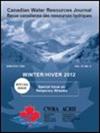Testing household preferences for the importance of the frequency and severity of water quality impairment
IF 0.9
4区 环境科学与生态学
Q3 WATER RESOURCES
引用次数: 1
Abstract
Abstract Water quality indices are employed by governments largely as a means of communicating the multifaceted nature of water quality and aquatic ecosystem health to the general public. Given the complexity of responsibility for oversight of freshwater quality in Canada, the Canadian Council of Ministers of the Environment (CCME) has developed an index based on the severity, frequency, and scope of water impairment. An important feature, and potential shortcoming, of this approach is that the three attributes of water quality are weighted equally. If households, however, weight these attributes differently, then the index’s ability to convey information to the public may be weakened. This issue is examined by eliciting household preferences for a hypothetical water quality protection program that reduces the severity and frequency of impairment using a discrete choice experiment (issues of scope are not included in the analysis). Latent class and mixed logit models are estimated. The latent class models, which outperform the mixed logit, indicate the presence of two preference classes that hold dramatically different preferences for benefits of the protection program. While one group of respondents is unresponsive to the severity and frequency of impairment, there is evidence that the other group may assign different weights to the attributes. These findings suggest the CCME index could convey different information to the two groups.测试家庭偏好对水质受损频率和严重程度的重要性
水质指数主要被政府用作向公众传达水质和水生生态系统健康的多面性的手段。鉴于加拿大监督淡水质量的责任的复杂性,加拿大环境部长理事会(CCME)根据水损害的严重程度、频率和范围制定了一个指数。这种方法的一个重要特征和潜在缺点是,水质的三个属性的权重是相等的。然而,如果家庭对这些属性的权重不同,那么该指数向公众传达信息的能力可能会减弱。这个问题是通过引出家庭对假设的水质保护计划的偏好来检验的,该计划使用离散选择实验来降低损害的严重性和频率(范围问题不包括在分析中)。估计潜在类和混合logit模型。潜类模型的表现优于混合逻辑,表明存在两个偏好类,它们对保护计划的好处有截然不同的偏好。虽然一组受访者对损害的严重程度和频率没有反应,但有证据表明,另一组可能会对这些属性赋予不同的权重。这些发现表明CCME指数可以向两组传递不同的信息。
本文章由计算机程序翻译,如有差异,请以英文原文为准。
求助全文
约1分钟内获得全文
求助全文
来源期刊

Canadian Water Resources Journal
WATER RESOURCES-
CiteScore
2.90
自引率
5.90%
发文量
17
审稿时长
>12 weeks
期刊介绍:
The Canadian Water Resources Journal accepts manuscripts in English or French and publishes abstracts in both official languages. Preference is given to manuscripts focusing on science and policy aspects of Canadian water management. Specifically, manuscripts should stimulate public awareness and understanding of Canada''s water resources, encourage recognition of the high priority of water as a resource, and provide new or increased knowledge on some aspect of Canada''s water.
The Canadian Water Resources Journal was first published in the fall of 1976 and it has grown in stature to be recognized as a quality and important publication in the water resources field.
 求助内容:
求助内容: 应助结果提醒方式:
应助结果提醒方式:


